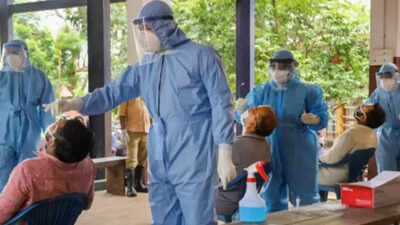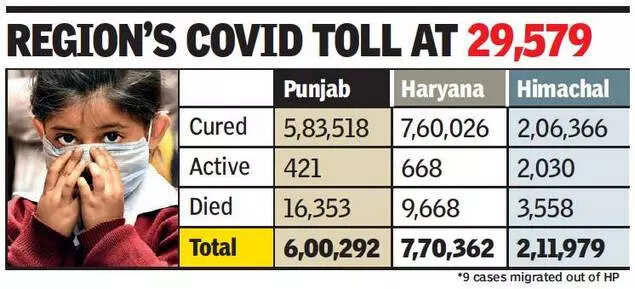- News
- City News
- chandigarh News
- Covid-19: Punjab records negative growth in weekly positivity rate
Covid-19: Punjab records negative growth in weekly positivity rate

Image used for representational purpose only
CHANDIGARH: After breaching the three-figure mark in August second week, the pandemic situation appears to be settling concurrently with negative growth in the weekly positivity rate recorded by a majority of the districts. During the week ending August 15, increase in the caseload was noted and experts had warned of situation flaring up if corrective steps were not taken. Punjab was clubbed with 10 other states of the country where the cases were expected to further increase.
In Punjab, the daily caseload touched 105 on August 11 and was expected to double in 64 days. The projections had set alarm bells ringing, forcing the government to tighten containment and management measures. Chief minister Amarinder Singh issued a warning of imposing new restrictions in addition to those already in force.

With focus on testing for early detection, the state’s testing scaled past national seven-day average of 1,366 tests per million population during the seven-day period.
Despite maintaining substantially high testing numbers, the weekly positivity rate, which refers to percentage of people who are Covid-19 positive out of total tested, posted negative growth in 13 districts while there was no change in eight districts.
Only Ferozepur posted increase in positivity rate. Unlike the week ending August 15, positivity rate jumped in nine districts while 10 noted no change and the rate dropped in three districts.
Punjab Covid-19 nodal officer Dr Rajesh Bhaskar said the health department was quick to respond when a slight uptick in cases was noted in the second week of the month and it helped to keep the numbers in control. “On an average, the health department is testing over 40,000 people. Besides, general population comprehensive testing is being carried out in schools,” he said.
In Punjab, the daily caseload touched 105 on August 11 and was expected to double in 64 days. The projections had set alarm bells ringing, forcing the government to tighten containment and management measures. Chief minister Amarinder Singh issued a warning of imposing new restrictions in addition to those already in force.

With focus on testing for early detection, the state’s testing scaled past national seven-day average of 1,366 tests per million population during the seven-day period.
Despite maintaining substantially high testing numbers, the weekly positivity rate, which refers to percentage of people who are Covid-19 positive out of total tested, posted negative growth in 13 districts while there was no change in eight districts.
Only Ferozepur posted increase in positivity rate. Unlike the week ending August 15, positivity rate jumped in nine districts while 10 noted no change and the rate dropped in three districts.
Punjab Covid-19 nodal officer Dr Rajesh Bhaskar said the health department was quick to respond when a slight uptick in cases was noted in the second week of the month and it helped to keep the numbers in control. “On an average, the health department is testing over 40,000 people. Besides, general population comprehensive testing is being carried out in schools,” he said.
FacebookTwitterLinkedinEMail
Start a Conversation
end of article
Quick Links
Delhi Air PollutionDelhi TemperatureChennai WeatherBangalore TemperatureCovid vaccination centres in DelhiCoronavirus in DelhiRTPCR test in GurgaonHyderabad RainPollution level in BangaloreDelhi SmogDelhi TemperatureNoida AQIGurgaon AQI todayFire in MumbaiMumbai RainsCovid 19 RT PCR Test in NoidaDelhi AQI todaySrinagar encounter

